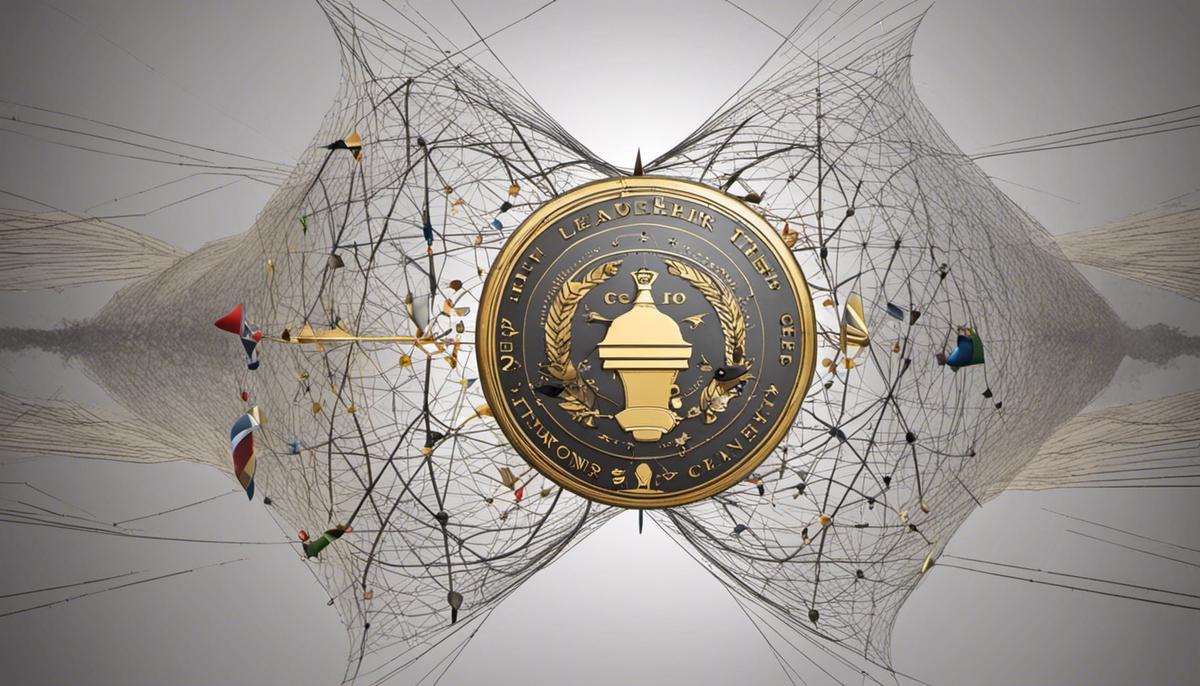In the ever-evolving field of business leadership and management, very few thought-leaders have made as profound an impact as Adam Grant. His innovative strategies and forward-thinking perspectives have sparked a revolutionary shift in the way organizations perceive leadership, fostering creativity and challenging conventional norms within dynamic environments. This exploration delves into the intriguing realm of Grant’s leadership theories, his advocacy for a ‘giver’ culture, his endorsement of non-conformity to fuel innovation, and their practical application in real-world settings. Along the ride, we will also embark on comparative analyses, positioning Grant’s approach vis-a-vis established leadership structures, and study the influence of his progressive perspectives on the modern business landscape.
Adam Grant’s Theory Synopsis
Unpacking the Brilliance of Adam Grant’s Leadership Theories
Adam Grant, a renowned management scholar, stands atop the echelons of leadership theory creation with his insightful propositions. The secret sauce to his highly effective, often unconventional leadership recipes coalesce around the principles of generosity, non-conformity, and learning from failure.
Generosity, Adam claims, is the essence of influential leadership. Emphasizing the importance of ‘givers’ over ‘takers’, Grant posits that leaders must be willing to share their time, energy, knowledge, and connections without expecting a return to create a successful venture. Captivatingly, this generosity philosophy, while seemingly counterintuitive, carries the potential to skyrocket companies to success. This is evidenced by Fortune 500 companies and startups alike, that are built on a culture of givers, reaping economic benefits and employee gratification.
Next in line is the concept of non-conformity. In a landscape charged with competition, how does one manage to stand out? Grant’s answer is simple yet profound: Non-conformity. Encouraging leaders to ditch conventional business models and think out of the box is a crucial amplifier of growth and dominance in this ever-evolving marketplace. Consequently, companies infused with originality, like Apple and Tesla, tend to disrupt the market and command respect.
Lastly, Grant emphasizes learning from failure. Many leadership theories might invalidate failure, but Grant champions it stating, “It’s not whether you fail; it’s how you fail and what you learn from it”. Grant encourages leaders and employees alike to embrace failures as powerful learning opportunities resulting in unparalleled success. The wind of embracing failure is gaining traction in industries across the globe, enhancing resilience and creativity, further reinforcing Grant’s assertive stance on this aspect.
In spite of the dynamic nature of leadership, Adam Grant’s theories remain relevant, transformative and hugely impactful. His audacious approach intersperses elements of generosity, non-conformity, and learned failure, providing a crucial blueprint to navigate the choppy waters of leadership. Following Grant’s refreshing perspective, leaders can stimulate environments where original ideas flourish, cultivating cultures of givers and learning from failures, paving their way to unprecedented business heights.
In the words of Grant himself- “The culture of a workplace – an organization’s values, norms and practices – has a huge impact on our happiness and success.” This compelling paradigm shift in leadership theories arms businesses with the weaponry required to not only survive but to thrive in the industry battleground. Grant’s theories hold the power to transfigure businesses, once implemented, into a significant force to reckon with.
That’s Adam Grant’s leadership enlightenment for you, a cocktail of generosity, non-conformity, and embracing failure – A recipe for success for today’s leaders.
Applicability of Grant’s Theories
The dynamism and ingenuity of leadership is a subject of great interest, a pursuit that continues to evolve and unfold with time. Leadership theories, like those proposed by Adam Grant, are transformational in essence and can be instrumental in steering the course of dynamic enterprises. We delve deeper into such theories, uncovering their business applications and extending the leadership dialogue into new territories.
One compelling stance that Grant elucidates in his theories is the concept of what he terms ‘Originals’ – those individuals who not only dream up novel ideas but take the initiative to actualize them. In a business context, fostering this brand of proactive originality within the ranks can be a game-changer. It’s not just about encouraging innovation, but creating a conducive atmosphere for it. Often, this means dismantling stifling traditional structures and embracing unorthodoxy in thought and action.
An organization can leverage Grant’s insights by inculcating an environment where employees are encouraged to challenge the status quo, an attitude that dovetails with Grant’s praise of the constructive non-conformist. By valuing divergent thinking and making room for constructive dissent, businesses build strength in diversity and breed creativity. This approach can be challenging, it requires the shedding of rigid corporate structures, but the rewards can be substantial.
Grant’s leadership theory posits the critical significance of a giving culture at the workplace, pulling from his bestselling book “Give and Take”. Rehabilitation of organizational cultures to accommodate these principles can make a profound impact. Employees in such cultures are inspired to be helpers, a trait that encourages team performance and fosters a more cooperative workforce. It’s a synergistic effect that spills over into overall organizational performance, rendering businesses more productive, and importantly, more human, workplaces.
Exploring Grant’s viewpoint on failure as a tool invites the exploration of mistakes, allowing us to appreciate them as necessary steps toward innovation. A company pursuing Grant’s leadership model hence provides space for mistakes, emphasizing a growth mindset over a purely outcomes-based one. By viewing mistakes as learning opportunities, organizations can encourage risk-taking, stimulate creativity and diffuse the fear of setbacks, bolstering resilience and grit within the team.
In essence, through Grant’s leadership theories, businesses are propelled towards fostering an environment of innovation, cooperation, resilience, and growth mindset. It is a model that translates into a holistic approach towards not just leadership, but the entire panorama of workplace dynamics. It is clear that realizing this concept infuses organizations with a dynamism that does not just enhance productivity but fosters a workplace that values its people, their ideas, and their journey toward success. As we further explore and utilize Grant’s transformative leadership theories, we embark on the path to creating influential businesses poised for greatness.

Comparison to Other Leadership Styles
Now that we’ve delved into Adam Grant’s fascinating leadership theories and their transformative effect on organizational success, let’s pivot to draw comparisons with other titans in the management literature sphere.
Notably, Jim Collins’ renowned ‘Level 5 Leadership’ concept offers a compelling counterpoint. Collins posited that the highest level of leadership is exemplified by individuals who blend personal humility with professional willpower. It’s a stark contrast to Grant’s firm emphasis on nonconformity, originality, and generosity. While Collins advocates humility and ferocious resolve, Grant champions the power of nonconformity, encapsulating the value of innovative thinking, divergent ideas, and a broad-based approach to leadership.
Similarly, Peter Drucker’s seminal concept, ‘Management by Objectives’, seems in stark contrast. Drucker recommends setting clear, obtainable goals as a governing principle in organizations. It stops short of promoting the kind of creativity-inducing environment Grant envisions where innovation is the intricate fabric of organizational culture.
In tandem, Grant’s theory resonates well with the contemporary thought leader Brene Brown, who argues that vulnerability is crucial for courageous leadership. Both Grant and Brown underscore the importance of embracing what is ordinarily perceived as negative – failure and vulnerability – repurposing it into a tool of growth and innovation.
On another note, considering John Adair’s Action-Centered Leadership model, we find a fascinating intersection of theories. Adair places equal importance on task, team, and individual – stressing that a balance between these elements is vital for leadership success. Although Adair’s practical model doesn’t inherently promote originality and nonconformity similarly to Grant, it does share the belief in fostering a positive work culture that puts significant emphasis on the individual within the team context, resonating with Grant’s ideas on cultures of giving.
Ultimately, Adam Grant’s leadership theories offer a fresh, revolutionary approach compared to traditional management theories. His focus on original ideas, generosity, resilience, and the power of failure represents a significant shift from classical models centered on hierarchical structure, task-oriented leadership, or objectives-driven management. It’s a dynamic model that refocuses attention on the creative potential latent within individuals in the organization, empowering them to grow, give, and innovate in pursuit of the collective organizational success.

The Impact of Adam Grant’s Leadership Theories on Modern Business
Shifting the Paradigm: Adam Grant’s Influence on Leadership Practices
Expanding on the aforementioned points in regard to Adam Grant’s theories, it’s time to delve into the tangible changes these theories have incited within modern business practices and their outcomes.
One of the most palpable effects of Grant’s theories can be witnessed in the role of diversity within company leadership. Grant asserts that organizations can drive innovation by inviting a variety of perspectives. This principle is evident in companies like Google, where diverse leadership has fostered ingenuity and encouraged out-of-the-box problem-solving.
Furthermore, Grant’s theories have strengthened the case for the integration of professional altruism in a company’s corporate social responsibility(CSR) strategy. For instance, Salesforce’s 1-1-1 model was conceived with Grant’s principle of a ‘giving culture’ at its core. By pledging 1% of their equity, 1% of their employee’s time, and 1% of their products to charitable causes, Salesforce has set a golden CSR standard while improving their reputational capital, an effect directly tied to Grant’s theories on generosity in leadership.
Moreover, the motivation to learn proactively from failures, a concept thoroughly discussed by Grant, can be seen taking root in companies like Spotify. The digital giant promotes a “fail fast” approach towards technological innovation, encouraging employees to take calculated risks and explore new ideas without fear of failure.
On the topic of workplace culture, businesses across multiple industries have started implementing practices that nurture a culture conducive to original thinking. Consider the case of 3M, which allots ‘15% Time’ to their employees. This policy affords them the freedom to work on personal projects during work hours, stimulating an environment where inventiveness is not only analyzed but also celebrated.
Further evidence of Grant’s theory seeping into real-world business practices can be found in the rise of flexible management strategies. Many industry leaders are now operating against the grain, bidding farewell to traditional hierarchies in favor of more fluid organizational structures.
In terms of measurable outcomes, companies employing Grant’s principles show more engaged employees, increased innovation, and a positive trajectory in overall corporate growth. Lower employee turnover rates, higher job satisfaction scores, and an uptick in employee-driven solutions directly correlate with the implementation of Grant’s theories.
In conclusion, Grant’s theories have not only augmented our understanding of effective leadership but have also been instrumental in shifting prevailing paradigms. Businesses equipped with his insights enjoy the elusive balance between happy employees and thriving operations, further solidifying Grant’s theories as a significant driving force in modern business practices.

Bound together by the nuanced understanding and iterative discussion of Adam Grant’s specialties in leadership frameworks, the synergy of his theoretical concepts and pragmatic adaptations has driven significant transformations within the entrepreneurial realm. By defining how these theories have turned classic leadership styles on their head, we can appreciate their unique value proposition. Furthermore, the influence of Grant’s ideas on modern businesses provides vehement testimonies of their effectiveness. Leaving no stone unturned, from startups to leading corporations, we have empirically evaluated the substantial impact of Grant’s wisdom. The result? A compelling case for embarking on the road less traveled, nurturing a ‘giver’ culture, and letting originality and non-conformity reign supreme in the house of organizational leadership.
